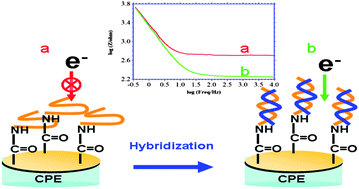In this paper, the poly-xanthurenic acid (PXa) was electropolymerized by cyclic voltammetry (CV) on a pre-obtained electrochemically reduced graphene oxide (ERGNO) film to construct a novel direct electrochemical DNA biosensor. Due to the unique properties of graphene, conjugated xanthurenic acid (Xa) monomers tended to be adsorbed on the graphene plane by π–π stacking and the electropolymerization efficiency was greatly improved, resulting in an enhanced electrochemical response of PXa. The PXa not only served as a substrate for DNA immobilization but also reflected the electrochemical transduction originating from DNA immobilization and hybridization without any outer indicators or complicated labeling. The capture probe was immobilized onto a modified electrode by covalent bonds between the amino groups of the capture probe and the carboxyl groups of the PXa/ERGNO film. The sensing platform could selectively recognize its target DNA. It is well-known that ssDNA is a flexible molecule while dsDNA acts as a rigid rod, which resulted in the change of the self-signals of the PXa after hybridization. The dynamic range of this DNA biosensor for detecting the sequence-specific DNA from promyelocytic leukemia was from 1.0 × 10−15 mol L−1 to 1.0 × 10−9 mol L−1 using electrochemical impedance spectroscopy, and the detection limit was 2.5 × 10−16 mol L−1.
